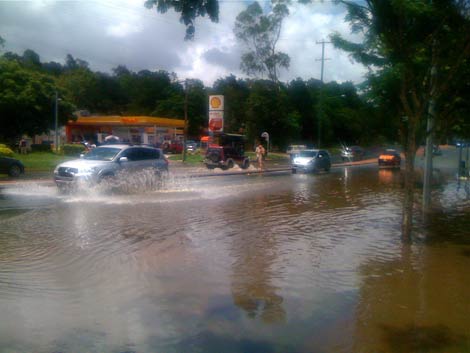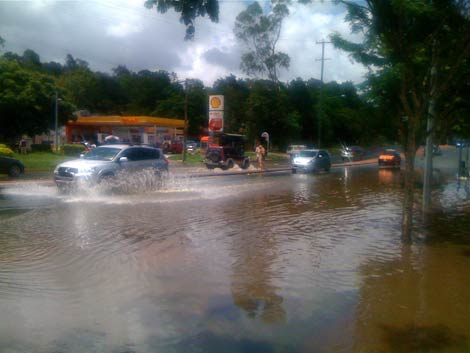 Photo: Dan HillSydney-based designer Dan Hill happened to be in Brisbane this week when floodwaters overtook the city. (Here’s our photo gallery of what that looks like, by the way — it’s pretty stunning.) Bad luck for him, good luck for the rest of us, because his coverage of the disaster is amazing. Writing (in a masterpiece of irony) by candlelight on an iPad, Hill has composed an extraordinary document, a melding of Twitter recap, photo essay, and thoughtful exegesis on the problems of modern city design. You should read it, but this is the internet, so most of you probably want to talk about it first. For you, here are the salient points:
Photo: Dan HillSydney-based designer Dan Hill happened to be in Brisbane this week when floodwaters overtook the city. (Here’s our photo gallery of what that looks like, by the way — it’s pretty stunning.) Bad luck for him, good luck for the rest of us, because his coverage of the disaster is amazing. Writing (in a masterpiece of irony) by candlelight on an iPad, Hill has composed an extraordinary document, a melding of Twitter recap, photo essay, and thoughtful exegesis on the problems of modern city design. You should read it, but this is the internet, so most of you probably want to talk about it first. For you, here are the salient points:
Crocodile Dundee is not blowing smoke: Australia is Xtreme. A disastrous 1974 flood killed 14 and submerged much of the area for weeks, and Queensland was drought-stricken for years before the sky opened up again. Yes, climate change causes greater extremes in weather, but Australia has always been meteorologically bipolar. And yet Brisbane wasn’t prepared for a flood of this magnitude. Why?
Little houses made of ticky-tacky: Hill describes the traditional “Queenslander” house design, which is up on stilts. These are, you might guess, quite useful if you’re going to build in a floodplain, and are in other ways designed around local idiosyncrasies (heat, bugs). But they’ve become luxury accommodations, because building on a slab is cheaper and easier. These generic builds aren’t suited to the current conditions. And they aren’t portable:
One of the more interesting proposals to emerge from the slowly disappearing seafront around Noosa, Queensland in recent years was called ‘planned retreat’, in which any new structures had to be designed to be plonked on a truck and driven away with 24 hour notice. The design possibilities, from miniature Archigram Walking Cities to Thom Mayne’s boat-houses for New Orleans, seem endless. And again, those Queenslander houses are often seen being transported around on the back of trucks (something I’d never seen before). Again, hard to match to a pattern of settlement that now builds the biggest, fattest houses in the world, but what new building possibilities might emerge from all this?
The cupboard is bare: You may have heard that your local grocery store only has a few days’ worth of food on hand. Here’s your proof. Brisbane’s supermarkets get their food from elsewhere, which works fine when elsewhere can access you. But what if the trucks can’t get through?
There is little or no distributed pattern of food production (just as more solar power would’ve been handy today, and yet is not installed much.) Again, a chance to rethink?
It feels incredibly fragile. There is already no bread in the shops, and milk and yoghurt long gone too. And no collective memory for producing such things from within any communities.
If you need to drive to it, it might as well not exist: Walkability is important for quality of life, but in a disaster, it may be life and death. If you live in the urban sprawl, you’re SOL if you can’t get to a mall or downtown, because that’s where all the necessary stuff is. Cities are more resilient when the stuff you need can be found on a small scale from neighborhood to neighborhood, not all clumped together in a megamall:
In Beirut, due to the variability of its fabric, everyday needs have to be met locally, as you’re never sure whether a road will be there or not. As a result, there is what you might call ‘network redundancy’ i.e. every few streets has a grocers, bakers, coffee shop, ironmongers, tailors etc. etc. This, as opposed to the centralised and consolidated model of western cities, most obviously visible in the out-of-town mall accessed by car, with all the apparent economies of scale that entails. Yet the former is actually more resilient, for sure. … It would have been better to have been in a place with a walkscore of something approaching 100 (see walkscore.com.) But there is nothing around us, barely pavements, and now the connecting infrastructure of roads is so easily compromised.
Virus with shoes: Is “natural disaster” the right term? It’s not much of a disaster for nature, Hill says — the critters are loving it. It’s the human infrastructure that can’t cope, an inflexible infrastructure that was plopped down on top of a particularly variable bit of nature, with the arrogance that characterizes human settlement. Can we set up cities so that what used to look like a “natural disaster” can be seen as just nature doing its thing? (Sarah Goodyear, Grist’s cities editor, has more on what doing that might entail.)
As far as i can see, nature is having a fine old time. Ducks, toads, insects, snakes, cockroaches, turtles — all are thriving. The water, so foreign to this terrain in recent years, is gulped greedily by the undergrowth. I’ve never seen Brisbane so green, so tropical. So it’s slightly solipsistic of us to describe it in terms like ‘disaster’. It’s only our inflexible, non-adaptive infrastructure that can’t cope with this.
And the infrastructure is failing for sure. Everything feels very contingent, very fragile. I spend a fair amount of time helping design various flavours of “resilient urbanism” in cities around the place, and it’s clear that this is not at all resilient.
Here’s the kicker: If you read nothing else in the article, read this.
There will be much finger-pointing after this, from insurance companies refusing to pay up due to the releases from dams not technically being floods (what on earth else are they then?); from those who point out that, as memory of the ’74 floods faded, developers were allowed to build in flood plains earmarked for further dams; from those pointing out that the floods are a result of climate change (even if these ones aren’t, future ones will be); from those pointing out that the entire fragile mode of suburban development of Australian cities is particularly unsuited to the resilience required of the near-future; that development should not have been allowed on the riversides and basins of floodplains, and so on.
There will be a time for discussing how to achieve more resilient patterns of settlement in Australia. I’m not at all convinced that Australians have the appetite for genuinely addressing this, even despite the floods. Most people are apparently incapable of thinking about the future on the scale required for investment in things like urban resilience, even accepting we need to get better at communicating all this. I’m not sure people see the connection between devastating flooding and a culture where property developers call the shots, where cost drives aspiration in building and infrastructure, and where a car-based fabric of dispersed tarmac’ed low-density communities is virtually the Australian dream. But if it’s not events like this, I’m not sure what else it would take to make this clear and force the issue.
Related stories:
- Deep water: The devastating flood of Brisbane [SLIDESHOW]
- What happened in Brisbane could happen to us


